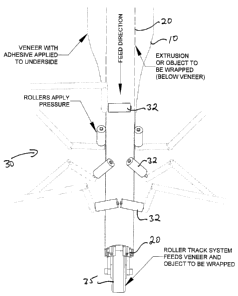Some of the information on this Web page has been provided by external sources. The Government of Canada is not responsible for the accuracy, reliability or currency of the information supplied by external sources. Users wishing to rely upon this information should consult directly with the source of the information. Content provided by external sources is not subject to official languages, privacy and accessibility requirements.
Any discrepancies in the text and image of the Claims and Abstract are due to differing posting times. Text of the Claims and Abstract are posted:
| (12) Patent: | (11) CA 2533721 |
|---|---|
| (54) English Title: | METHOD FOR WRAPPING A NON-POROUS SUBSTRATE OBJECT WITH A WOOD VENEER |
| (54) French Title: | METHODE POUR RECOUVRIR UN SUBSTRAT NON POREUX AVEC UNE FEUILLE DE BOIS |
| Status: | Granted |
| (51) International Patent Classification (IPC): |
|
|---|---|
| (72) Inventors : |
|
| (73) Owners : |
|
| (71) Applicants : |
|
| (74) Agent: | VASS, WILLIAM B. |
| (74) Associate agent: | |
| (45) Issued: | 2014-09-23 |
| (22) Filed Date: | 2006-01-24 |
| (41) Open to Public Inspection: | 2006-07-25 |
| Examination requested: | 2011-01-24 |
| Availability of licence: | N/A |
| (25) Language of filing: | English |
| Patent Cooperation Treaty (PCT): | No |
|---|
| (30) Application Priority Data: | ||||||
|---|---|---|---|---|---|---|
|
There is described a method for at least partially covering selected surfaces of a non-porous substrate with a flexible veneer, the method comprising the steps of maintaining a humid environment during the covering of said substrate with the veneer, applying a preheated adhesive to one or both of the substrate and the veneer, progressively shaping the veneer to the selected surfaces of the substrate through the application of pressure biasing the veneer against the selected surfaces and curing the assembly of the veneer and the substrate.
Description dun procédé permettant de couvrir au moins partiellement des surfaces sélectionnées dun substrat non poreux au moyen dun placage flexible, le procédé comprenant les étapes de maintien dun milieu humide durant le recouvrement dudit substrat avec le placage, dapplication dun adhésif préchauffé sur le substrat ou le placage, ou les deux, dadaptation progressive du placage aux surfaces choisies du substrat par lapplication de pression afin que le placage épouse les surfaces choisies, et de durcissement de lensemble du placage et du substrat.
Note: Claims are shown in the official language in which they were submitted.
Note: Descriptions are shown in the official language in which they were submitted.

For a clearer understanding of the status of the application/patent presented on this page, the site Disclaimer , as well as the definitions for Patent , Administrative Status , Maintenance Fee and Payment History should be consulted.
| Title | Date |
|---|---|
| Forecasted Issue Date | 2014-09-23 |
| (22) Filed | 2006-01-24 |
| (41) Open to Public Inspection | 2006-07-25 |
| Examination Requested | 2011-01-24 |
| (45) Issued | 2014-09-23 |
There is no abandonment history.
Last Payment of $624.00 was received on 2024-01-19
Upcoming maintenance fee amounts
| Description | Date | Amount |
|---|---|---|
| Next Payment if standard fee | 2025-01-24 | $624.00 |
| Next Payment if small entity fee | 2025-01-24 | $253.00 |
Note : If the full payment has not been received on or before the date indicated, a further fee may be required which may be one of the following
Patent fees are adjusted on the 1st of January every year. The amounts above are the current amounts if received by December 31 of the current year.
Please refer to the CIPO
Patent Fees
web page to see all current fee amounts.
Note: Records showing the ownership history in alphabetical order.
| Current Owners on Record |
|---|
| DIRTT ENVIRONMENTAL SOLUTIONS LTD. |
| Past Owners on Record |
|---|
| GOSLING, GEOFF |
| SMED, MOGENS |